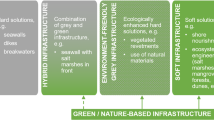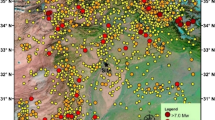Abstract
A systematic investigation using digital microearthquake recorders with short period SS-1 seismometers, covering 76 sites in and around Agartala city, has been carried out for site response (SR) studies in the area. In the northern part of the area, SR varies from 1.15 to 1.85 corresponding to peak frequency 0.76 to 0.93 Hz where soil is mostly semi-consolidated and stiffer than recent Quaternary deposits (Haora River formation). In the southern part of the area, SR varies from 1.12 to 2.42 corresponding to peak frequency from 0.71 to 0.85 Hz within the Dupitila formation (early Quaternary). It is observed that estimated SR from H/V increases from edges to middle of the Haora River valley and impedance contrast fallows the similar trend. This reflects that site response by H/V is influenced by impedance contrast, whereas computed amplification from 1-D model shows opposite trend. The maximum amplification at fundamental frequency of resonance, 1.04 Hz estimated from H/V by near to BH-7, is 2.5 times greater than the impedance contrast/ratio derived from 1-D model for same location. Relationship between resonance frequency and depth was obtained by applying quarter wavelength and Bard (2000) methodologies, which shows linearity, whereas H/V shows its nonlinearity characteristic in soil across the valley part of Haora River. Shear wave velocities, and subsequently, SPT index and factor of safety (by cyclic stress approach) were estimated from geotechnical parameters. Vs30 and site response data were used in this study for getting a first hand information about soil stiffness condition in the area. The estimation of SPT index and factor of safety could be a useful tool for delineating liquefied and none liquefied zones at various depth levels, especially where water table exists at a very shallow level. The expected liquefiable zone was observed at depths varying from 6–25 m beneath the soil bearing zones where percentage of fines is estimated to be more than 35% for the area. This knowledge about subsurface soil characteristics will be useful for the civil engineers/city planners, which can be taken into account at the time of constructing earthquake-resistant structures in the area.








Similar content being viewed by others
References
Al Yuncha Z, Luzon F, Posadas A, Martin J, Albuacic G, Almendro J, Sanchez S (2001) The use of ambient seismic noise measurements for the estimation of surface soil effects: the Montril city case (Southern Spain). Pure Appl Geophys 161:1549–1559
Almendros J, Luzon F, Posadas A (2004) Microtremor analyses at Teide volcano (Canary Island, Spain): assessment of natural frequencies of vibration using time-dependent horizontal to vertical spectral ratios. Pure Appl Geophys 161:1579–1596
Bard PY (2000) Lecture notes on seismology seismic hazard assessment and risk mitigation. International Training course, Potsdam, p 160
Bard PY, Bouchon M (1985) The two-dimensional resonance of sediment field valleys. Bull Seism Soc Am 75:519–541
Bard PY, Lachet C (1994) Numerical and theoretical investigations and a more standardized SPT.” In: Proceedings, 9th international conference on soil mechanics and foundation engineering, Tokyo, vol 2, pp 269–276
Borcherdt RD, Glassmayer (1989) A December 1988 near Spitak, Armania, U.S.Geol Survey. Open file Report, 89-163A, Der Kiureghian and E Cranswick, Results and data from Seismologic and geologic studies following earthquakes
Campbel KW (2003) Strong–motion attenuation relation. International hand book of earthquake and Engineering seismology, vol 81B, Chap 60, pp 1003–1012
Celebi MC, Dietee C, Prime J, Onate M, Chare GZ (1987) Site amplification in Maxico City (determined from 19, September 1985 Strong motion records and from recording of weak motion), Grand motion and Eng Seis. In: Cakmak AS (ed), Elsevier, pp 141–152
Chowdhuri SN, Singh OP, Mishra OP, Kayal JR (2008) Microzonation study from ambient noise measurement for assessing site effects in Krishnagar area and significance. Indian Min 61(3–40), 62 (1–4):183–192
Faccioli E, Pessina V (2003) Case of Engineering seismology tools in ground shaking scenario. International hand book of earthquake and Engineering seismology, vol 81B, Chap 62, pp 1031–1048
Field EH, Jacob KH (1990) Using microtremors to assess potential earthquake site response: a case study in Flushing Meadows. New York City. Bull Seism Soc Am 80:1456–1480
Field EH, Jacob KH (1993) The theoretical response of sedimentary layers to ambient seismic noise. Geophys Res Lett 20:2925–2928
Havskov J, Ottemoeller L (2001) Seisan software manual. University of Bergen, Norway
Hough SE, Field EH, Jacob KH, Jacob KH (1991) Using microtremors toassess site specific earthquake hazard. In: Proceedings of the fourth international conference on sites zonation. Stanford Univ Ca, Aug 25–29, 3, pp 585–592
Ibs-Von Seht M, Wohlenberg J (1999) Microtremor measurement used to map thickness of soft sediments. Bull Seis Soc Am 89:1250–1259
Kawase H (2003) Site effect on strong Ground motion. International hand book of earthquake and Engineering seismology, vol 81B, Chap 61, pp 1013–1030
King JL, Tucker BE (1984) Dependence of sediment filled valley response on the input amplitude and valley properties. Bull Seism Soc Am 74:153–165
Kovacs WD, Evans JC, Griffiths AH (1977) Toward a more standardized SPT, “Presentation 9th International Conference on Soil Mechanics and Foundation Engineering, Tokyo, vol 2, pp 269–276
Lermo J, Rodriguez M, Singh SK (1988) The Mexico earthquake of September 19, 1985—Natural period of sites in the Valley of Mexico from microtremor measurements and strong motion data. Earthq Spectr 4:805–814
Matti JC, Carsoni SE (1991) Liquefaction susceptibility in San Bernardino valley and vicinity, Southern California—a regional Evaluation. US Geol Survey Bull 1898:53
Nakamura Y (1989) A method for dynamic characteristics estimation of sub-surface using micro tremors on the ground surface. Quarterly reports of the Railway Technical Research Institute Tokyo, 30, pp 25–33
Nakamura (2000) Clear identification of fundamental idea of Nakamura’s Technique and its applications
Nandy DR (1995) Neotectonism and seismic hazards in India. Indian J Geol 67(1):34–48
Ohmachi T, Nakamura Y, Toshinava T (1991) Ground motion characteristics in the San Francisco Bay area detected by microtremor measurements. In: Proceedings of the 2nd international conference on recent adv in Geot Earth Eng and Soil Dvyn, 11–15 March, St. Louis, Missouri, pp 1643–1648
Parolai S, Bormann P, Milkereit C (2002) New relationship between Vs, thickness of sediments and response frequency calculated by H/V ratio of seismic noise for cologne area. Bull Seismol Soc Am 92:2521–2527
Ranjan G, Rao ASR (2005) Basic and applied soil mechanics, vol 6, 2nd edn. New Age International Publication, New Delhi, pp 128–172
Rial JA, Saltzman NG, Ling H (1992) Earthquake-induced resonance in sedimentary basins. Am Sci 80:566–578
Sarangi B, Natani JV, Sontherandam P, Ramamurthy S, Meherotra B (1989) “Investigation for hard resources, silica sand and plastic clay in Tripura. G.S.I. Publication
Seed HB, Idriss IM (1970)”Soil moduli and damping factors for dynamic response analysis” Report EER 70-10, Earthquake Engineering Research Centre University of California, Barkeley
Seed HB, Idriss IM, Makdisi FI, Banerjee N (1975) “Representation of irregular stress time histories by equivalent uniform stress series in liquefeaction analysis” EER 70-10, Earthquake Engineering Research Centre University of California, Berkeley
Shenbaga RK (1999) Design aids in soil mechanics and foundation engineering, Chap 6, p 70
Singh SK, Lermo J, Dominguz T, Ordaz M, Espinosa JM, Mena E, Quass R (1988) The Maxico earthquake of September 19, 1985- A study of amplification of seismic waves in the valley of Maxico with repectto hill zone site. Eartq Spectr 4:653–673
Steven LK (2004) Ground response analysis. Geotech Earthq Eng, Chap 7, 254–307
Tezarghi K, Peck RB (1967) Soil mechanics in engineering practice. Wiley, NY
Author information
Authors and Affiliations
Corresponding author
Rights and permissions
About this article
Cite this article
Chowdhuri, S.N., Singh, O.P. & Majumdar, R.K. Site response studies in Agartala Urban agglomeration. Nat Hazards 59, 329–345 (2011). https://doi.org/10.1007/s11069-011-9759-y
Received:
Accepted:
Published:
Issue Date:
DOI: https://doi.org/10.1007/s11069-011-9759-y




